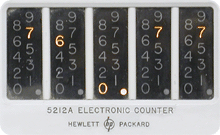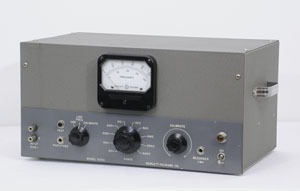 |
The HP 500A Frequency Meter |
Before the Counter there was the Meter
The very first occurrence of an electronic device to measure frequency was only 3 years after the company's creation. It was a natural complement to the early Hewlett Packard audio oscillator production. The 500A, analog electronic frequency meter was described as follow in the 1943 catalog:
The frequency meter consists of a wide band amplifier with a limiting circuit, and electronic switch, a constant current supply, a frequency discriminating circuit, and an output meter and rectifier. The input signal is amplified and used to switch the constant current source to alternate load resistors. The voltage developed across these resistors is applied to a condenser, and the output meter indicates the average value of the rectified charging current. The circuit is designed so that each pulse of charging current has the same average value, making the meter reading
proportional to the number of charges per second, and hence proportional to the frequency of the input signal. The reading is practically independent of the input voltage wave form, as normal wave form errors cannot affect the electronic switching operation. The regulated current source makes the
reading independent of variations in input signal voltage and line voltage. A multiplier switch in the meter circuit provides ten convenient scale ranges. Provision is made for checking the calibration against power line frequency, and an adjustment is provided for changing the overall calibration if necessary.
This technique gave the HP 500A a usable measurement range of 10 cps to 50,000 cps, with full scale meter deflection switched in 1, 2, 5, 10 sequences. An input voltage of at least 0.5 volts was required in the input impedance of 50,000 Ohms and the overall accuracy was plus or minus 2% of full scale value.
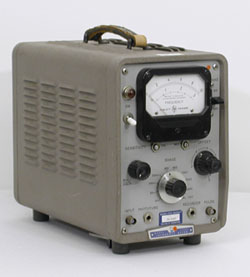 |
The HP 500B Frequency Meter
|
1955 - HP 500B Frequency Meter
Even if digital frequency counters already existed in 1955, frequency meters kept some obvious interests in the low frequency spectrum: Low cost, and output voltage proportional to the meter reading for analog recording.
The 500B evolution of the 500A offered another output jack on its front panel which provided a discriminator output for FM measurement and monitoring.
Other improvements brought by the 500B were:
A wider frequency range, extended to 100,000 cps on the high end and 3 cps on the low end.
A 3 to 10 time expendable scale feature enables frequency changes to be measured with increased accuracy.
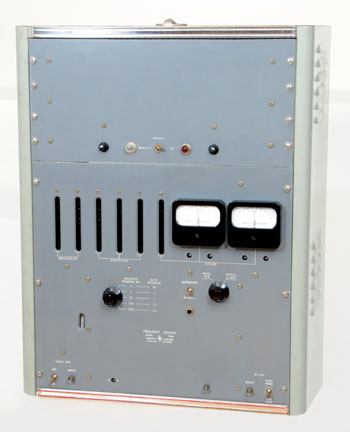 |
The HP 524A Frequency Meter |
The Second HP Leadership
Just as the 1940s HP leadership in audio instrumentation was triggered by the Bill Hewlett's 200A oscillator the 1951, HP 524A frequency counter would be the second "big success" product. This started the very long HP leadership in frequency measurement. John Minck 's narrative gives a precise analysis of how the digital frequency counter at HP began:
"As the nation recovered from WWII, the atomic energy business was big time. Not only was nuclear research welcomed, but all sorts of other nuclear advances were predicted, from chemical to pharmaceuticals to medicine. Crucial to such developments was the measuring instrumentation that was needed for nuclear data. Pulse counting and energy profiling was one area that appealed to HP.
The pulses, of course, were those derived from nucleus decay and detected by various crystalline sensors. The horsepower race of those days, was to build counters that count higher and higher rates of decay, and discriminate between two closely-separated radiation pulses, the closer the better.
A fellowship grant made to Al Bagley, a young graduate student at Stanford University in 1948, led to the development of HP's frequency counter business. Hewlett and Packard personally asked student Bagley to study the measurement needs of the nuclear physics industry. From that study came requirements for a faster nuclear-pulse-counting technology, that could resolve two nuclear events, only 0.1 microsecond apart. Bagley determined that new, low-capacitance semiconductor diodes, just coming on the market might allow faster digital circuitry. He built a prototype as part of his project—and asked for a job at HP.
Out of that work, came the HP 520A high speed decimal scaler, which was able to condition very short nuclear pulses, occurring at up to 10 mc. It also divided down the count rate by factors of 10 or 100. Sadly, the 520A had only minimal commercial success. However, Hewlett envisioned a different measurement process, one that gated those scaled-down, high-speed pulses into a slower-speed accumulator (counter). It used a selectable time base, similar to that of the earlier WWII HP 100A time standard. Out of this combination was born the common frequency counter.
Those "combination" frequency counters were a huge commercial success, and in great demand from the 1950's onward. They were used in measuring everything from transmitter frequencies to the accelerometers on which ballistic missile guidance systems were based. HP became the industry leader in electronic counting, in the early 1950's, with the HP 524A frequency counter (ca. 1952), which boasted a 0.01 cps to 10 "mc" measuring range. (Hertz came a little later.)"
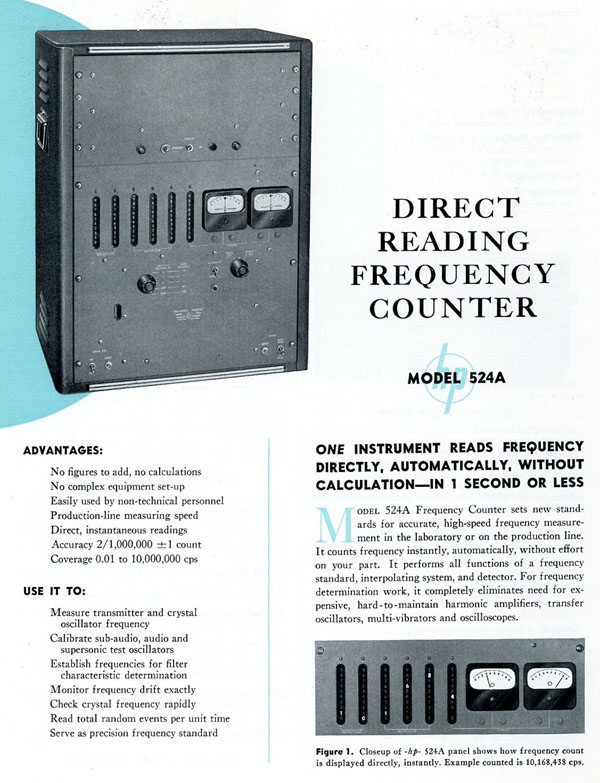 |
Main Specifications of the 524A Frequency Counter in the 1952 Catalog 21-A
Courtesy of the Hewlett Packard company |
A Companion for the 524A
Introduced in 1953, the HP 512A Frequency Converter is a companion for the HP 524A Frequency Counter. It extends the range of the 524A upward from 10 mc to 100 mc, and is also arranged to increase the sensitivity of the frequency counter for measurements between 100 kc and 10 mc.
The HP 512A multiply the 100 kc time base of the HP 524A frequency counter to obtain a 10 mc frequency from which standard decade mixing frequencies are derived. The unknow frequency is located approximately using the range switch, the tuning dial, and the tuning-eye of the 512A. The decade multiple of 10 mc below the unknow frequency is then selected. The frequency registered on the counter is added to the decade multiple of 10 mc selected to obtain the exact unknow frequency.
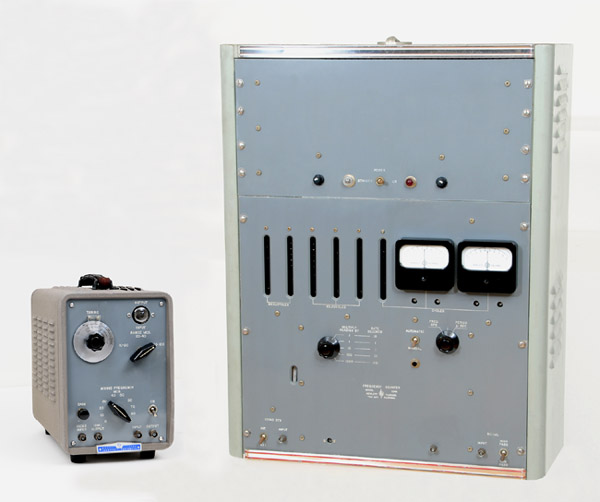 |
| The HP 512A Frequency Converter and 524A Frequency Counter |
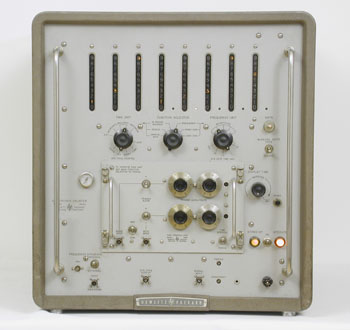 |
HP 524D Frequency Counter with 526B Time Interval Drawer
|
The HP 524 Counter Evolution
In 1954, plug-in down-converters were added and introduced as the HP 524B electronic counter, which became an industry standard for some years. 4 Plug-ins were available for the 524B:
The 525A Frequency Converter extended counter's basic 10 cps to 10 mc range up to 100 mc
The 525B Frequency Converter gave counter range from 100 to 220 mc.
The 526A Video Amplifier increased counter's sensitivity to 10 millivolts for low level work.
The 526B Time Interval Unit (shown in the 524D photo on left) measured intervals, 1 microsecond to 100 days with an accuracy of 0.1 microsecond.
 |
| Closeup of the HP Memory collection HP 524D Frequency Counter display, measuring a 13,912,396 Hertz signal |
A Frequency Range Extended to Microwave
In 1955 the HP 540A Transfer Oscillator was introduced. Connected to a 524B Counter with a 525A Converter Plug-in installed, frequencies up to 12 KMC could be measured.
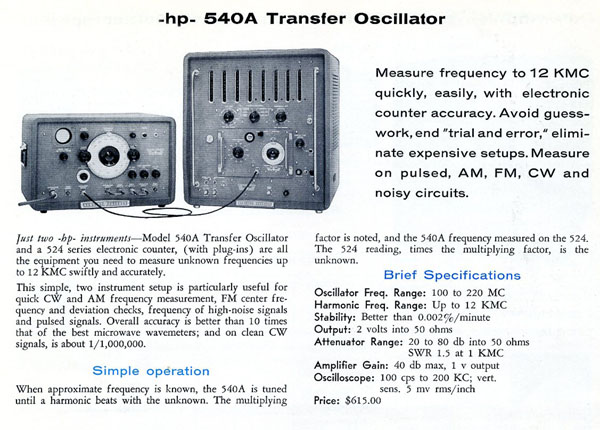 |
HP 540A Transfer Oscillator & HP 524D Frequency Counter in the 1958 short-form catalog
Courtesy of the Hewlett Packard company |
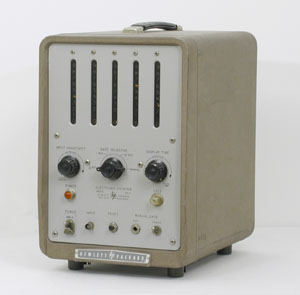 |
The HP 521C Frequency Counter |
The First Portable and Low Cost Frequency Counter
The 521A introduced in 1955 was the first occurence of a moderately priced, small size frequency counter. $475 for 12 Kg to be compared to the $2,500 and 55 Kg of the 524B open the field of frequency measurement out of the lab.
From 1 cps to 120 Kcs, the 521A measures frequency, speed, rpm and rps and counts events occurring at random within a selected period of time. With proper transducers converting mechanical into electrical phenomena, the instrument will also measure weight, pressure, temperature, acceleration and other quantities which can be related to frequency. This is one more sign in HP's strategy to enpand their product lines to provide answers to the many problems found in industry.
As shown in the diagrams below, two models of such a transducer were available for the measurement of rotating shaft speeds of up to 300,000 rpm.
Animation Display: Interior Panoramic View of the HP 521C
Animation |
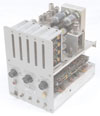 |
|
 |
| Drawing from Hewlett-Packard Journal July, 1955 - Courtesy of the Hewlett Packard company |
 |
The HP 524C Frequency Counter |
HP 524 Series, 1959 Last Improvement: NIXIES, for a Bright, Big-numbered, In Line Readout
The 1959 catalog introduced the last upgrade of the 524 series. The 524C (photo on the right) replaced the difficult to read, vertical column, neon lamp display by a full 8-digit bright, big-numbered, in-line Nixies readout, with automatic illuminated decimal point.
In the basic 524C counter, (without plug-in units) frequency range from 10 Hz to 10 MHz is read over 5 selected gate times from 1 millisecond to 10 seconds.
A choice of 5 different plug-in units, (picture below) and the HP 540A transfer oscillator shown above, give the 524C a usable measurement frequency range from 10 Hz to 12.4 GHz, and a time interval measurement range from 1 microsecond to 100 days.
| HP Memory Project Collection of Plug-in Units Compatible with the HP 524 Series Counters |
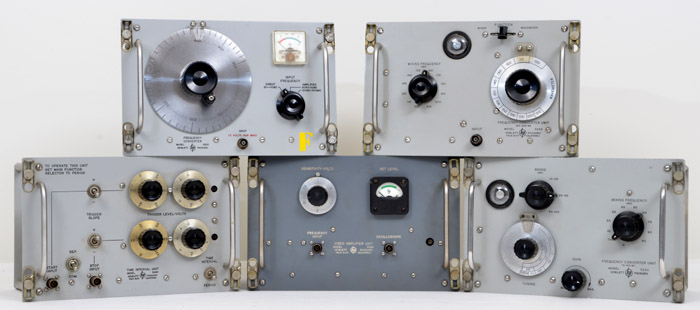 |
Top left: HP 525C, 100 to 500 MHz Frequency Converter - Top right: 100 to 220 MHz Frequency Converter
Bottom left: HP 526B, Time Interval Unit - Center: HP 526A, Video Amplifier Unit - Bottom right: HP 525A, 10 to 100 MHz Frequency Converter |
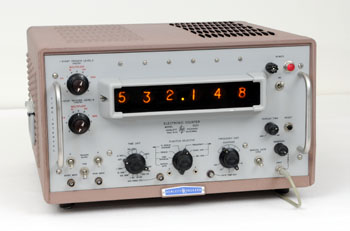 |
HP 523C Frequency Counter
|
The HP 523C Universal Counter
As the last improvement of the 1950s, the Model 523C was introduced in the 1959 catalog. It was the first of a category which came to named "Universal Counter" some years later.
The Model 523C went well beyond the simple measurement of electronic signal frequencies, it easily measures period, time interval, phase delay, random events and ratios.
It also features significant improvements in sensitivity and trigger level circuitry, which sets this instrument apart from its predecessors. Operation of the 523C is simple, fast and accurate. Measurements are made automatically and readings are displayed in direct numerical form on six in-line nixie tubes with automatic decimal point.
The 523C measures sine wave frequencies from 10 cycles to 1.2 MC and the repetition rates of periodic or random pulses from 0 to 1,200,000 pps. Gate times of 0.001, 0.01, 0.1, 1 or 10 seconds are selected with a front panel band switch. Display time is adjustable from 0.1 second to 5 seconds, or readings may be retained until reset manually.
From a collector point of view, this counter was in a rarely seen in "Mint condition". The seller sent it to me in a package which included the original dust cover inside which the instrument probably spent its last fifty years. We seldom find a 50 year-old item in such a like new condition. It is worth the top inside view picture shown below, which gives, by the way, a good idea of the huge quantity of vacuum tubes required by the construction of logic circuits of that era.
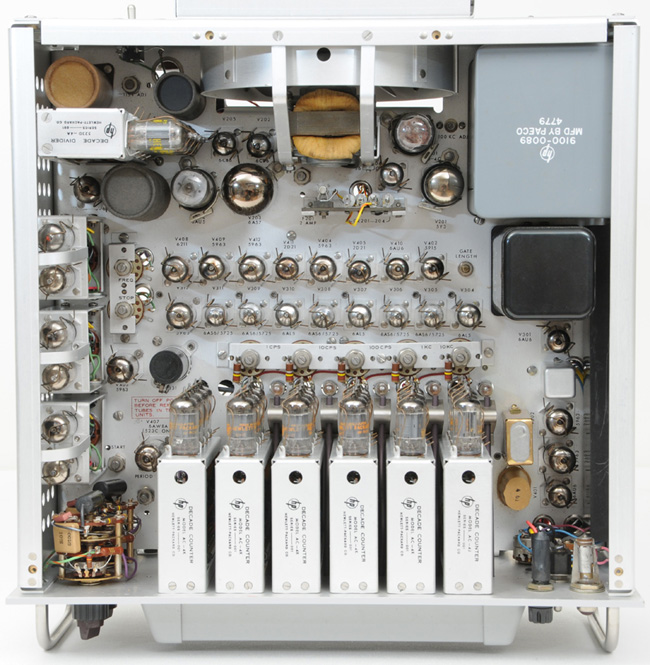 |
| Top Inside View of the HP 523C Counter. A lot of Tubes |
A Young but Solid Product Line, Ready to grow . . .
In these late 1950s, 8 years after the birth of the first HP 524A, the HP frequency counter product line already boasts more than ten different models. This family of products is ready for the considerable demand that the technology progress will generate in the next decade. The range of performance of these instruments of the first generation serves measurement applications well, and we should not forget how they increased their performance to match new domain of measurements that advancing technologies demanded. Many of these measurements were simply not in the horizon only a few years before, and the HP practice of inventing new measurement processes and their associated written applications notes brought new dimensions in speed and accuracy. The future will continue bright.
Hewlett Packard remembers that our engineer customer who are pushing out the frontiers of RF and microwave systems need the best and ultimate in counting technologies. So we pioneer in every new field of counting applications. Some measurement applications include: Oscillator stability - Power line frequencies - Production quantities - Nuclear radiations - Rps and Rpm - Very low frequencies - Repitition rates - Elapsed time between impulses - Pulse lengths - Shutter speeds - Projectile velocity - Precise event timing - Relay operating time - Interval stability - Frequency ratios - Phase delay - Phase angle - Weight, pressure, temperature and acceleration (remotely). To list just a few...


